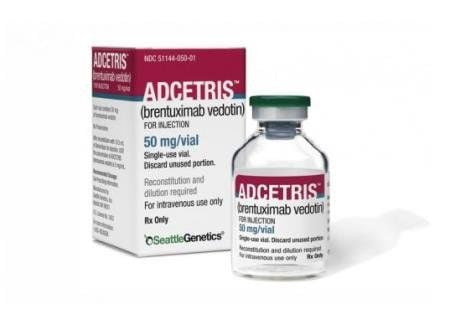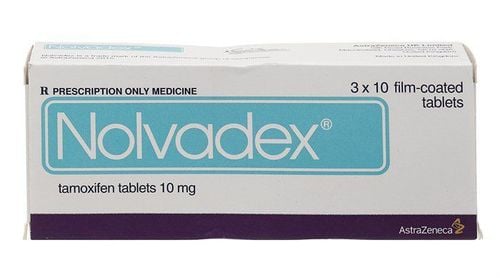This is an automatically translated article.
Teniposide belongs to the group of anti-cancer drugs and is used alone or in combination with other anti-cancer drugs in the treatment of lymphoma and acute lymphoblastic leukemia. To better understand what drug Teniposide is? What are the uses of Teniposide? What are the possible side effects of Teniposide? What is the correct way to drink? What points do you need to pay attention to, and note when using? The following article will help you better understand Teniposide drug.1. Effects of Teniposide
Generic name (Active ingredient): Teniposide (Teniposide)
Type of drug: Anti-cancer drug
Drug form and strength: Syringe 50 mg/5 ml (for intravenous infusion after dilution). Teniposide is a stage-specific, cytotoxic drug that acts at the end of the S phase or the beginning of the G2 phase of the cell cycle, thereby preventing cells from entering mitosis. Dose-dependent teniposide disrupts single- and double-stranded DNA and in DNA-protein cross-linking. The exact mechanism of action of teniposide is unknown, possibly due to inhibition of topoisomerase II activity because teniposide does not intercalate between DNA or bind strongly to DNA. The cytotoxic effect of teniposide is related to the relative amount of DNA double-strand breaks in the cell. That reflects the stability of topoisomerase II - DNA intermediate.
Teniposide has a broad spectrum of anti-tumor activity in vivo including leukemia and various solid tumors. Notably, teniposide is active against a subline of several leukemias resistant to cisplatin, doxorubicin, amsacrin, daunorubicin, mitoxantron or vincristine.
2. Usage of the drug Teniposide
2.1. Teniposide administration Prior to intravenous infusion, teniposide injection concentrate must be diluted with 5% dextrose injection solution or 0.9% sodium chloride solution to obtain a final teniposide concentration of 0.1; 0.2; 0.4 or 1 mg/ml.
Intravenous catheters or intravenous needles must be placed carefully to prevent drug leakage from the vessel wall, which can cause local tissue necrosis and/or thrombophlebitis. The patient must be carefully monitored, as obstruction at the intravenous infusion site, including venous catheter occlusion, is possible, especially during prolonged infusion (eg, 24 hours) at concentrations of 0.1 mg/ml or 0. ,2 mg/ml. Teniposide 1.0 mg/ml solution should be used within 4 hours to reduce the possibility of precipitation.
Adults Monotherapy:
Doses vary widely: May be 30 mg/m2/day for 10 days, or 30 mg/m2 every 5 days, or 50-100 mg/m2 once a week. The duration of using Teniposide for treatment depends on the results of hematological tests.
Multi-chemotherapy:
For acute lymphoblastic leukemia that is resistant to other drugs, use teniposide 165 mg/m2 and cytarabine 300 mg/m2 (intravenous infusion) twice a week, for 8 or 9 such doses.
Other combination: Teniposide 250 mg/m2 and vincristine 1.5 mg/m2 (intravenous infusion) once a week for 4-8 weeks and oral prednisone 40 mg/m2/day for 28 days.
Children A study showed the efficacy of teniposide in combination with cytarabine in acute leukemia patients resistant to other cytarabine-containing regimens: Teniposide 165 mg/m2 and cytarabin 300 mg/m2 IV twice/ week for 8 - 9 weeks.
Another study demonstrating the efficacy of teniposide in combination with vincristine and prednisolone when resistant to other vincristine/prednisolone-containing regimens: Teniposide 250 mg/m2 and vincristine 1.5 mg/m2 IV weekly for 4 to 8 weeks ; prednisolone 40 mg/m2 orally for 28 days.
Other people Leukemia with Down syndrome must reduce the dose.
Patients with renal or hepatic dysfunction: Dosage adjustment may be required.
2.2. Teniposide Overdosage and Missing Dose Missing Teniposide and Management
This medication is done by healthcare professionals so it is less likely that a patient will miss a dose.
Overdose and management
Overdose and toxicity
There is no specific antidote. Complications of overdose are the result of bone marrow suppression.
How to deal with drug overdose
Supportive treatment with blood products and antibiotics .
2.3. Teniposide Drug Interactions Caution should be exercised when teniposide is administered concomitantly with drugs that displace teniposide from protein binding, such as tolbutamide, sodium salicylate and sulfamethizol, leading to increased teniposide toxicity. There was no change in the plasma pharmacokinetics of teniposide when co-administered with methotrexate. However, there was a slight increase in the plasma clearance of methotrexate and an increase in the intracellular concentration of methotrexate.
Antiemetics together with high doses of teniposide can cause acute CNS depression and hypotension.
Anticonvulsants such as phenytoin , carbamazepine and phenobarbital increase the metabolism of teniposide in the liver and decrease the drug concentration in the body.
Ciclosporin reduces the clearance of teniposide, prolongs the half-life, increases plasma concentrations and toxicity of teniposide.
2.4. Drug interactions with food Tenoposide taken with grapefruit juice, can increase drug plasma concentrations.
Drug interactions can change how the drug works or increase the effect of side effects. This document does not cover all possible drug interactions. Write a list of all the medicines you are taking (including prescription, nonprescription and dietary supplements) and show them to your doctor or pharmacist.
3. Contraindications of Teniposide
Hypersensitivity to teniposide or to any of its ingredients, pregnancy.4. Notes when using the drug Teniposide
General notes when taking Teniposide Teniposide should be used with caution and dose reduction in patients with impaired renal or hepatic function; people with hypoalbuminemia; people with Down syndrome.
Liver function should be checked regularly during and after teniposide treatment. Renal function should be checked before, during and after teniposide therapy.
Note to pregnant women Teniposide can harm the fetus when treating pregnant women; The drug is teratogenic and embryotoxic in laboratory animals, therefore teniposide should not be administered to pregnant women.
Note to lactating women It is not known whether teniposide is excreted in human milk; Because of the potential for serious adverse effects in children, a decision must be made whether to discontinue nursing or discontinue the drug, taking into account the importance of the drug to the mother.
Precautions while driving and operating machinery No reports.
5. Teniposide side effects
Get medical help right away if you experience any of these signs of an allergic reaction: hives, difficulty breathing, swelling in your face, lips, tongue or throat.
Call your doctor right away if you have any of the following serious side effects:
Fever, chills, itching, body aches, flu symptoms, sore mouth and throat; easy bruising, unusual bleeding (nose, mouth, vagina, or rectum), small purple or red spots under the skin; pale skin, feeling light-headed or short of breath, fast heart rate, decreased ability to concentrate; fast or pounding heartbeat, wheezing, chest pain, breathing problems; severe headache, ringing in the ears, anxiety, confusion, chest pain, irregular heartbeat; Soreness, burning, irritation, or changes in the skin where the injection was given; Feeling of possibly passing out; Severe nausea and vomiting. Less serious side effects include:
Mild headache; Drowsiness, lightheadedness, feeling tired or weak; Mild nausea, abdominal pain, loss of appetite; Constipation, diarrhea ; Temporary hair loss; Mild skin rash. This is not a complete list of side effects and others may occur. If you have any questions about side effects, consult your doctor or pharmacist.
6. How to store Teniposide thuốc
Teniposide at a final concentration of 0.1; 0.2; 0.4 mg/ml, stable at room temperature for 24 hours. A solution of 1.0 mg/ml concentration must be used within 4 hours of preparation to reduce the possibility of drug precipitation. However, precipitation has been observed when reconstituting an infusion solution containing 0.2 mg/ml teniposide in 5% glucose or 0.9% sodium chloride. Dilution of teniposide infusion solution at a concentration lower than 0.1 mg/ml reduces this phenomenon. Heparin sodium can cause precipitation of teniposide. Therefore, the infusion set should be thoroughly rinsed with 5% dextrose or 0.9% sodium chloride before and after teniposide infusion.
Teniposide in a sealed syringe (manufacturer's preparation in the original packaging) is stable until the expiration date indicated on the package when the drug is stored refrigerated (2 – 8 oC) in the package and protected from light. shining.
Vinmec International General Hospital is one of the hospitals that not only ensures professional quality with a team of leading medical doctors, modern equipment and technology, but also stands out for its examination and consultation services. comprehensive and professional medical consultation and treatment; civilized, polite, safe and sterile medical examination and treatment space.
Please dial HOTLINE for more information or register for an appointment HERE. Download MyVinmec app to make appointments faster and to manage your bookings easily.













